Alchornea ilicifolia
Alchornea ilicifolia, commonly known as the native holly, is a bush of eastern Australia. It grows in or on the edges of the drier rainforests in coastal parts of New South Wales and Queensland.
| Native holly | |
|---|---|
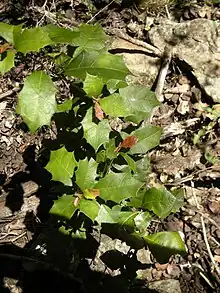 | |
| Mount Archer National Park, Australia | |
| Scientific classification | |
| Kingdom: | Plantae |
| Clade: | Tracheophytes |
| Clade: | Angiosperms |
| Clade: | Eudicots |
| Clade: | Rosids |
| Order: | Malpighiales |
| Family: | Euphorbiaceae |
| Genus: | Alchornea |
| Species: | A. ilicifolia |
| Binomial name | |
| Alchornea ilicifolia | |
| Synonyms[3] | |
|
Homotypic Heterotypic | |
Description
The native holly is a shrub or rarely a small tree up to 6 m (20 ft) tall and with a trunk that is usually crooked, with pale grey smooth bark, with some pustules and lenticels. Small branches greenish or fawn in color, with paler lenticels.[4][5] The leaves are holly-like in appearance, 2 to 8 cm (0.79 to 3.15 in) long and 2 to 5 cm (0.79 to 1.97 in) wide.[4][5][6] They are ovate or rhomboidal in shape with three or four acute lobes on each side, each of which is armed with a sharp spine.[4][5][6] They are stiff and glabrous with a petiole around 3 mm (0.12 in) long.[4][5][6]
Flowers and fruit
Greenish flowers appear in November, on racemes up to 5 cm (2.0 in) long, with male and female flowers on separate plants.[4][5][6] The fruit is a dark brown, three-lobed capsule about 6 to 8 mm (0.24 to 0.31 in) in diameter, each lobe containing one seed.[4][5][6] The plant may flower and fruit at any time of year after rain events.[5]
Taxonomy
The botanist John Smith originally described this species as Caelebogyne ilicifolia in 1839, from three specimens collected by Allan Cunningham in 1829.[7] The Swiss botanist Johann Müller gave it its current name in 1865.[2] The generic name Alchornea honours the English botanist Stanesby Alchorne,[8] while the species epithet ilicifolia refers to the holly-like leaves (Ilex).
Distribution and habitat
This species grows in vine thickets and monsoon forest on a variety of soil types, from Jamberoo on the south coast of New South Wales to Atherton in far north Queensland.[4][5][6]
Ecology
Alchornea ilicifolia is a host plant for the larvae of the common albatross butterfly and the moth Dichomeris mesoctenis.[9][10]
Gallery
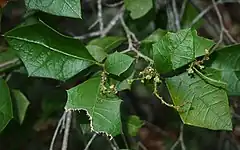 Flowers
Flowers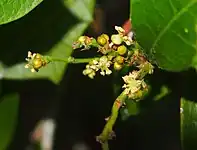 Flowers
Flowers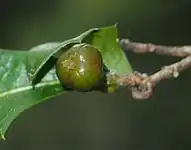 Unripe fruit
Unripe fruit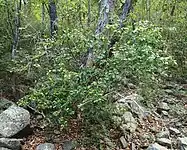 Habit
Habit
References
- "Species profile—Alchornea ilicifolia". Queensland Department of Environment and Science. Queensland Government. 2022. Retrieved 31 March 2023.
- "Alchornea ilicifolia". Australian Plant Name Index (APNI). Centre for Plant Biodiversity Research, Australian Government. Retrieved 31 March 2023.
- "Alchornea ilicifolia (Js.Sm.) Müll.Arg". Plants of the World Online. Royal Botanic Gardens, Kew. Retrieved 31 March 2023.
- "PlantNET - FloraOnline". PlantNET (The NSW Plant Information Network System). Royal Botanic Gardens and Domain Trust, Sydney. Retrieved 31 March 2023.
- Forster, Paul I. (2022). Moon, C.; Orchard, A.E. (eds.). "Alchornea ilicifolia". Flora of Australia. Australian Biological Resources Study, Department of Climate Change, the Environment and Water: Canberra. Retrieved 31 March 2023.
- F.A.Zich; B.P.M.Hyland; T.Whiffen; R.A.Kerrigan (2020). "Alchornea ilicifolia". Australian Tropical Rainforest Plants Edition 8 (RFK8). Centre for Australian National Biodiversity Research (CANBR), Australian Government. Retrieved 31 March 2023.
- Smith, John (1839). "Notice of a Plant which produces perfect Seeds without any apparent Action of Pollen". Transactions of the Linnean Society of London. 18 (4): 509. doi:10.1111/j.1095-8339.1838.tb00200.x. Retrieved 31 March 2023.
- Cooper, Wendy; Cooper, William T. (June 2004). Fruits of the Australian Tropical Rainforest. Clifton Hill, Victoria, Australia: Nokomis Editions. p. 171. ISBN 9780958174213.
- "Alchornea ilicifolia (EUPHORBIACEAE); Native holly". Archived from the original on 26 June 2010. Retrieved 21 March 2010.
- Robinson, Gaden S.; Ackery, Phillip R.; Kitching, Ian; Beccaloni, George W.; Hernández, Luis M. (2023). "HOSTS". HOSTS - a Database of the World's Lepidopteran Hostplants. Natural History Museum. Retrieved 31 March 2023.
External links
 Data related to Alchornea ilicifolia at Wikispecies
Data related to Alchornea ilicifolia at Wikispecies Media related to Alchornea ilicifolia at Wikimedia Commons
Media related to Alchornea ilicifolia at Wikimedia Commons- View a map of historical sightings of this species at the Australasian Virtual Herbarium
- View observations of this species on iNaturalist
- View images of this species on Flickriver